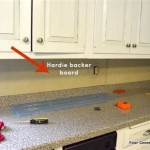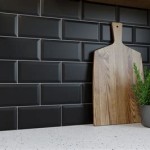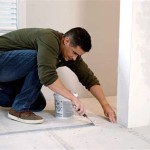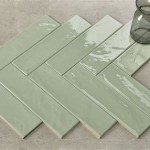How To Remove Vinyl Tile From Concrete Floor
Removing vinyl tile from a concrete floor is a common undertaking for homeowners and contractors alike when renovating or repairing a space. While the process can be labor-intensive, understanding the proper techniques and utilizing the right tools can significantly improve efficiency and minimize damage to the underlying concrete. This article provides a comprehensive guide to removing vinyl tile effectively, encompassing surface preparation, various removal methods, and essential safety precautions.
Before commencing any removal work, a thorough assessment of the existing vinyl tile and the concrete floor beneath is crucial. This assessment helps to identify the type of adhesive used, the condition of the concrete, and potential hazards, such as asbestos. Older vinyl tiles, particularly those installed before the 1980s, may contain asbestos fibers. Disturbing these tiles without proper precautions can release harmful particles into the air, posing a serious health risk. If there is any suspicion of asbestos content, professional testing and abatement services are strongly recommended.
Assuming the vinyl tile is asbestos-free, the next step involves gathering the necessary tools and materials. These typically include a heat gun or steamer, a floor scraper (available in various widths and blade designs), a putty knife, a hammer, safety glasses, gloves, a dust mask, and sturdy work shoes. Depending on the severity of the adhesive bond, additional tools such as a chemical adhesive remover, a chisel, and a shop vacuum may be required. Proper ventilation is essential throughout the entire process, especially if using chemical removers. Opening windows and using fans can help to circulate fresh air and minimize exposure to fumes.
Preparing the Work Area
Preparation is a critical step that contributes significantly to the efficiency and effectiveness of vinyl tile removal. The initial step involves clearing the work area of all furniture, appliances, and any other obstructions. This provides ample space to maneuver and work without impediments. Covering nearby surfaces, such as walls and baseboards, with plastic sheeting or drop cloths is also advisable. This precaution helps to protect these surfaces from potential damage caused by scraping tools, adhesive residue, or dust. Securing the plastic sheeting with painter’s tape ensures a secure and protective barrier.
Following the clearing and protection of the surrounding area, sweep or vacuum the entire floor surface to remove any loose debris, dirt, or dust. A clean surface allows for better heat penetration or chemical adhesion, depending on the chosen removal method. Ensuring a clean surface also reduces the risk of scratching or damaging the concrete floor during the removal process. Addressing any uneven areas or loose tiles prior to initiating the primary removal method can also streamline the process.
Finally, before applying heat or chemicals, it’s important to test a small, inconspicuous area to assess the effectiveness of the chosen technique and to identify any potential adverse reactions with the concrete or remaining adhesive. This "test patch" allows for adjustments to the method or the selection of a different approach if necessary, minimizing the risk of widespread damage or ineffective removal efforts. Observation of the testing area should span for at least an hour to allow time for any reactions to occur. This proactive approach saves time and resources in the long run.
Applying Heat to Loosen the Adhesive
Applying heat is a commonly employed method for softening the adhesive bonds that secure vinyl tiles to concrete floors. This method is particularly effective on tiles that are adhered with pressure-sensitive adhesives. A heat gun is a popular tool for this purpose, as it allows for targeted application of heat directly to the tile surface. When using a heat gun, it's crucial to maintain a consistent distance from the tile to avoid scorching the vinyl or damaging the adhesive. A slow, sweeping motion across the tile surface ensures even heat distribution.
Another effective option is utilizing a steamer. Steam penetrates the tile and softens the adhesive from underneath, making it easier to lift the tile from the concrete. Steamers are generally considered a safer option compared to heat guns, as they reduce the risk of overheating and scorching. When using a steamer, direct the steam nozzle towards the edges of the tile, allowing the steam to penetrate the adhesive. After a short period of steaming, attempt to lift the tile with a scraper or putty knife. The adhesive should be softened enough to allow for relatively easy removal.
Regardless of whether a heat gun or steamer is used, it’s imperative to exercise caution to avoid burns. Wear heat-resistant gloves and protect the eyes with safety glasses. It's also important to be mindful of the potential for flammable materials in the vicinity and to avoid overheating any one area for prolonged periods. The goal is to soften the adhesive, not to melt or burn the vinyl. Regularly check the tile’s pliability and the adhesive’s condition to determine if adequate heat application has been achieved. If the tile still resists removal, reapply heat for a short additional duration.
Using a Floor Scraper and Chemical Removers
Once the adhesive has been softened through the application of heat or steam, a floor scraper is the primary tool for lifting and removing the vinyl tiles. Floor scrapers come in various sizes and blade designs, each suited for different types of flooring and adhesive strengths. A wider scraper is generally more efficient for removing large areas, while a narrower scraper may be more effective for detail work or reaching difficult corners. Proper scraping technique involves inserting the scraper blade under the edge of the tile and applying steady, even pressure while pushing the scraper forward. The goal is to lift the tile in one piece, minimizing the amount of adhesive residue left behind.
In some cases, heating or steaming alone might not be sufficient to loosen stubborn adhesive. In such situations, chemical adhesive removers can be employed. These removers are formulated to break down the chemical bonds within the adhesive, making it easier to scrape away. When using chemical removers, it’s crucial to follow the manufacturer’s instructions carefully regarding application, dwell time, and safety precautions. Many adhesive removers contain volatile organic compounds (VOCs) and can pose health risks if not used properly. Adequate ventilation is paramount, and wearing appropriate personal protective equipment, such as gloves and a respirator, is essential.
After applying the chemical remover and allowing it to dwell for the specified time, test a small area to assess its effectiveness. If the adhesive has softened sufficiently, proceed with scraping the tiles. If the adhesive remains resistant, reapply the chemical remover and allow it to dwell for a longer period. It's important to avoid over-applying chemical removers, as excessive use can damage the concrete floor. Once the tiles have been removed, the concrete surface will likely have residual adhesive. This residue can be scraped away using a putty knife or a specialized adhesive scraper. For particularly stubborn residue, another application of chemical remover may be necessary.
After the vinyl tiles and any residual adhesive have been removed, the concrete floor may require further preparation before installing new flooring. This may involve patching any cracks or holes, leveling uneven areas, and thoroughly cleaning the surface to remove any remaining debris or chemical residue. Consulting with a flooring professional can provide valuable guidance on the specific preparation requirements for the chosen new flooring material.

How To Remove Vinyl Flooring Residue From Concrete Slab 3 Methods And They Work Or Don T

How To Remove Vinyl Tiles From Concrete Flooring Supplies

How To Remove Vinyl Flooring Pvc Tiles Rolls From Concrete Slab

The Fastest Way To Remove Bonded Vinyl Flooring From Concrete

How To Remove Tile From A Concrete Floor

How To Remove Vct Tile From A Concrete Subfloor Diy Projects

How To Remove Vinyl Tiles Fast

Removal How To Remove Old Vinyl Tiles Home Improvement Stack Exchange

How To Remove Vinyl Flooring

How To Remove L And Stick Vinyl Tile Flooring From Concrete Bathroom Makeover On A Budget Ep 3
Related Posts








